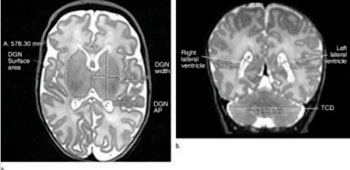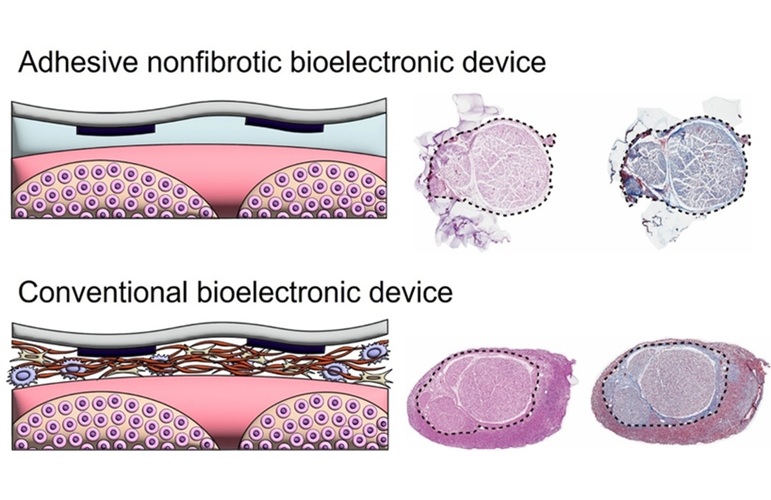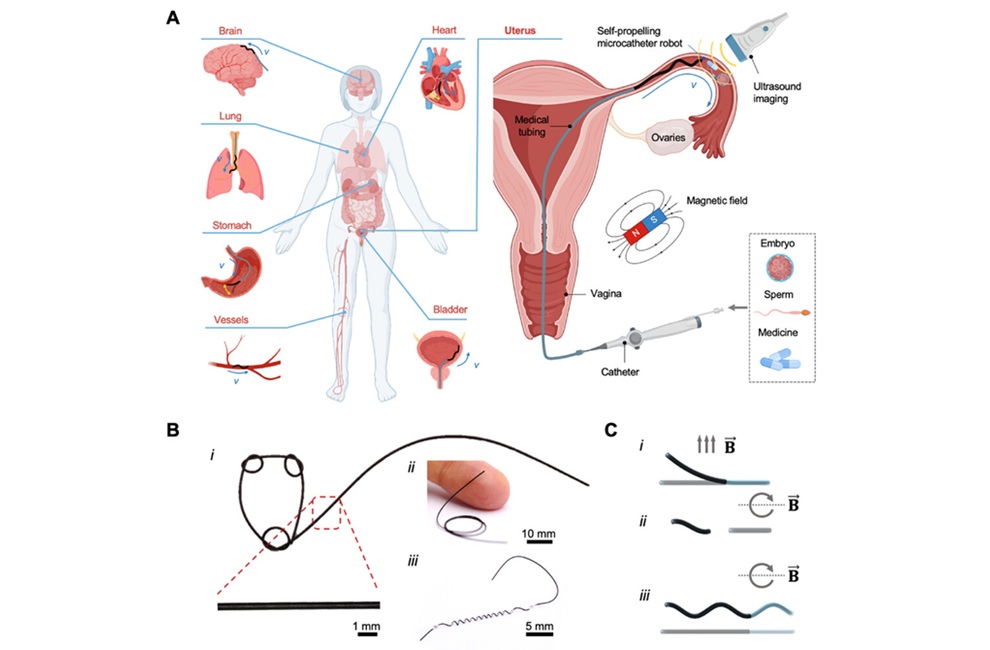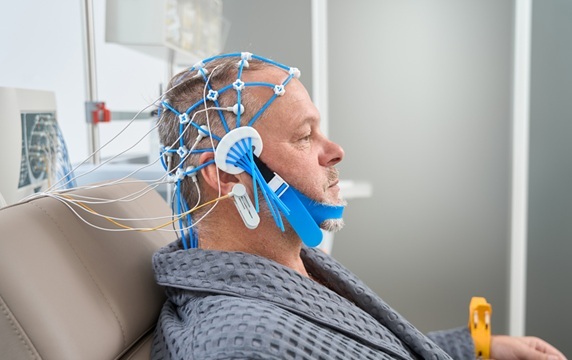Brain Abnormalities Revealed in Late Preterm Infants Using MRI
|
By HospiMedica International staff writers Posted on 17 Jun 2014 |

Image: (a) Axial T2-weighted image shows deep gray nuclei (DGN) width, anteroposterior (AP) distance, and surface area. (b) Coronal T2- weighted image shows lateral ventricle atrial measures and transverse cerebellar diameter (TCD) (Photo courtesy of the Radiological Society of North America).
Infants born 32 to 36 weeks into gestation may have smaller brains and other brain defects that could lead to long-term developmental difficulties, according to a new imaging study.
A lot of the existing information on preterm birth and brain development has been gathered from studies of individuals born very preterm, or less than 32 weeks into gestation at birth.
For the new study, published online June 2014 in the journal Radiology, researchers in Australia focused on moderate and late preterm (MLPT) infants—those born between 32 weeks, zero days, and 36 weeks, six days, into gestation. MLPT babies account for approximately 80% of all preterm births and are responsible for much of the rise in the rates of preterm births over the last 20 years. In spite of this, up to now there have been no large-scale studies published on brain alterations linked with MLPT births that may offer clues into brain-behavior relationships in this group of children.
“In those very preterm babies, brain injury from bleeding into the brain or a lack of blood flow, oxygen or nutrition to the brain may explain some of the abnormal brain development that occurs,” said the study’s lead author, Jennifer M. Walsh, MBBCh, BAO., MRCPI, from the Royal Women’s Hospital (Melbourne, Australia). “However, in some preterm babies, there may be no obvious explanation for why their brain development appears slow compared with babies born on time.”
The researchers performed magnetic resonance imaging (MRI) scanning on 199 MLPT and 50 full-term-born infants (greater than 37 weeks gestation) between 38 to 44 weeks of gestation. They searched for symptoms of brain injury and compared the size and maturation of multiple brain structures in the two groups. Whereas injury rates were similar between the two groups, MLPT births were tied to smaller brain size at full-term-equivalent age. Furthermore, MLPT infants had less developed myelination in one part of the brain and more immature gyral folding compared with full term-born controls.
The findings suggest that MLPT births may disrupt the predicted course of brain growth that would normally occur in the last two or so months in utero, according to Dr. Walsh. “Given that brain growth is very rapid in the last one-third of pregnancy, it is perhaps not surprising that being born during this potentially vulnerable period may disrupt brain development,” she said.
The researchers are hoping to better determine the impact that moderate to late preterm birth has on the brain, so that they can then begin to try different treatments designed to enhance brain function and long-term outcome in these infants. “Medications, along with early intervention to help parents understand their baby’s needs, have been effective in helping very preterm babies catch up to their term-born peers,” Dr. Walsh said. “However, whether any of the existing treatments will help babies born between 32 and 36 weeks is unknown, as they have not been studied very much at all.”
The researchers plan to follow the infants in the study group through childhood to learn more about the relationship between brain abnormalities and later outcomes. They also are evaluating additional MRI information about brain structure and function in these children. “Understanding what problems they have and what might be causing them is the first step in trying to improve their long-term outcome,” Dr. Walsh said.
Related Links:
Royal Women’s Hospital
A lot of the existing information on preterm birth and brain development has been gathered from studies of individuals born very preterm, or less than 32 weeks into gestation at birth.
For the new study, published online June 2014 in the journal Radiology, researchers in Australia focused on moderate and late preterm (MLPT) infants—those born between 32 weeks, zero days, and 36 weeks, six days, into gestation. MLPT babies account for approximately 80% of all preterm births and are responsible for much of the rise in the rates of preterm births over the last 20 years. In spite of this, up to now there have been no large-scale studies published on brain alterations linked with MLPT births that may offer clues into brain-behavior relationships in this group of children.
“In those very preterm babies, brain injury from bleeding into the brain or a lack of blood flow, oxygen or nutrition to the brain may explain some of the abnormal brain development that occurs,” said the study’s lead author, Jennifer M. Walsh, MBBCh, BAO., MRCPI, from the Royal Women’s Hospital (Melbourne, Australia). “However, in some preterm babies, there may be no obvious explanation for why their brain development appears slow compared with babies born on time.”
The researchers performed magnetic resonance imaging (MRI) scanning on 199 MLPT and 50 full-term-born infants (greater than 37 weeks gestation) between 38 to 44 weeks of gestation. They searched for symptoms of brain injury and compared the size and maturation of multiple brain structures in the two groups. Whereas injury rates were similar between the two groups, MLPT births were tied to smaller brain size at full-term-equivalent age. Furthermore, MLPT infants had less developed myelination in one part of the brain and more immature gyral folding compared with full term-born controls.
The findings suggest that MLPT births may disrupt the predicted course of brain growth that would normally occur in the last two or so months in utero, according to Dr. Walsh. “Given that brain growth is very rapid in the last one-third of pregnancy, it is perhaps not surprising that being born during this potentially vulnerable period may disrupt brain development,” she said.
The researchers are hoping to better determine the impact that moderate to late preterm birth has on the brain, so that they can then begin to try different treatments designed to enhance brain function and long-term outcome in these infants. “Medications, along with early intervention to help parents understand their baby’s needs, have been effective in helping very preterm babies catch up to their term-born peers,” Dr. Walsh said. “However, whether any of the existing treatments will help babies born between 32 and 36 weeks is unknown, as they have not been studied very much at all.”
The researchers plan to follow the infants in the study group through childhood to learn more about the relationship between brain abnormalities and later outcomes. They also are evaluating additional MRI information about brain structure and function in these children. “Understanding what problems they have and what might be causing them is the first step in trying to improve their long-term outcome,” Dr. Walsh said.
Related Links:
Royal Women’s Hospital
Latest Critical Care News
- Bioadhesive Strategy Prevents Fibrosis Around Device Implants on Peripheral Nerves
- Miniature Non-Invasive Robotic Catheters to Improve Infertility Treatments
- Stick-On Patch Monitors Baby's Movements In Utero
- EEG-Based AI Technology Accurately Diagnoses Alzheimer’s and Dementia
- Robot Lymphatic System Paves Way for Self-Powered Wearables and Machines
- Focused Ultrasound Technique Successfully Treats Pediatric Brain Cancer
- Nasal Drops Fight Brain Tumors Noninvasively
- AI Helps Optimize Therapy Selection and Dosing for Septic Shock
- Glowing Bacteria ‘Pills’ for Detecting Gut Diseases Could Eliminate Colonoscopies
- Skin-Permeable Polymer Patch Delivers Insulin Non-Invasively Through Skin
- Nanogel Technology Almost 100% Effective in Destroying Drug-Resistant Bacteria Within Hours
- Wearable Ultrasound Sensor Delivers Noninvasive Treatment Without Surgery
- Gel-Free ECG System to Transform Heart Health Diagnosis
- Biodegradable Patch Repairs Damaged Tissue After Heart Attack
- Magnetically Guided Microrobots to Enable Targeted Drug Delivery

- Smart Nanomaterials Detect and Treat Traumatic Brain Injuries Simultaneously
Channels
Critical Care
view channel
Bioadhesive Strategy Prevents Fibrosis Around Device Implants on Peripheral Nerves
Peripheral nerves connect the brain and spinal cord to muscles, organs, and sensory systems, making them key targets for treating neurological and systemic diseases. However, implantable bioelectronic... Read more
Miniature Non-Invasive Robotic Catheters to Improve Infertility Treatments
Minimally invasive procedures in reproductive and gynaecological medicine are often limited by the difficulty of navigating narrow, delicate anatomical pathways without damaging surrounding tissue.... Read moreSurgical Techniques
view channel
Catheter-Based Procedures Offer Less Invasive Option for Treatment of Valvular Disease
Valvular heart disease, caused by tight or leaky valves between heart chambers, affects up to 10% of older adults and leads to more than 120,000 deaths globally each year. Traditional open-heart surgery... Read moreLaparoscopic Surgery Improves Outcomes for Severe Newborn Liver Disease
Biliary atresia is a rare but life-threatening liver condition in newborns that blocks bile flow and leads to progressive liver damage if not treated early. Surgery is typically performed within the first... Read morePatient Care
view channel
Revolutionary Automatic IV-Line Flushing Device to Enhance Infusion Care
More than 80% of in-hospital patients receive intravenous (IV) therapy. Every dose of IV medicine delivered in a small volume (<250 mL) infusion bag should be followed by subsequent flushing to ensure... Read more
VR Training Tool Combats Contamination of Portable Medical Equipment
Healthcare-associated infections (HAIs) impact one in every 31 patients, cause nearly 100,000 deaths each year, and cost USD 28.4 billion in direct medical expenses. Notably, up to 75% of these infections... Read more
Portable Biosensor Platform to Reduce Hospital-Acquired Infections
Approximately 4 million patients in the European Union acquire healthcare-associated infections (HAIs) or nosocomial infections each year, with around 37,000 deaths directly resulting from these infections,... Read moreFirst-Of-Its-Kind Portable Germicidal Light Technology Disinfects High-Touch Clinical Surfaces in Seconds
Reducing healthcare-acquired infections (HAIs) remains a pressing issue within global healthcare systems. In the United States alone, 1.7 million patients contract HAIs annually, leading to approximately... Read moreHealth IT
view channel
EMR-Based Tool Predicts Graft Failure After Kidney Transplant
Kidney transplantation offers patients with end-stage kidney disease longer survival and better quality of life than dialysis, yet graft failure remains a major challenge. Although a successful transplant... Read more
Printable Molecule-Selective Nanoparticles Enable Mass Production of Wearable Biosensors
The future of medicine is likely to focus on the personalization of healthcare—understanding exactly what an individual requires and delivering the appropriate combination of nutrients, metabolites, and... Read moreBusiness
view channel
Philips and Masimo Partner to Advance Patient Monitoring Measurement Technologies
Royal Philips (Amsterdam, Netherlands) and Masimo (Irvine, California, USA) have renewed their multi-year strategic collaboration, combining Philips’ expertise in patient monitoring with Masimo’s noninvasive... Read more
B. Braun Acquires Digital Microsurgery Company True Digital Surgery
The high-end microsurgery market in neurosurgery, spine, and ENT is undergoing a significant transformation. Traditional analog microscopes are giving way to digital exoscopes, which provide improved visualization,... Read more
CMEF 2025 to Promote Holistic and High-Quality Development of Medical and Health Industry
The 92nd China International Medical Equipment Fair (CMEF 2025) Autumn Exhibition is scheduled to be held from September 26 to 29 at the China Import and Export Fair Complex (Canton Fair Complex) in Guangzhou.... Read more
















